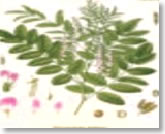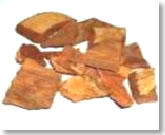
MADHU YASHTI
Botanical Name: Glycyrrhiza glabra
English Name: Liquorice
Hindi Name: Mulethi

Introduction: Madhuka or Madhuyashitak is known for physicians since Vedic period. Atharva Parisista considered this ploant as good for foetal growth/ Garbha brmhana. It was also used for the treatment of poisons of animal origin/ jangama visha ( Pa.Gr. 1/21). It is extensively described by Charaka with various indications and properties. This plant enjoys the distinction of laxative as well as emetic. Its anti-oxidant, immunomodulatory, anti-inflammataory, anti-microbial property etc are known to Indian medicine.
Distribution: It is a hardy herb or undershrub, Jammu & Kashmir, Punjab and Sub-Jhimalayan tracts under cultivation.
Chemical Constituents: They include glycyrrhizin, glycyrrhizic acid, glycyrrhetinic acid, liquirtin, glabrine, licochalocones A & B etc.
Parts Used: Root
Properties: Sweet, cooling, anti-oxidant, aphrodisiac, good for eyes, soothing agent, anti-microbial, anti-inflammatory etc.
Indications: Visha rogas, vranasotha, chardi, kshaya, raktapitta, vatarakta etc.
Dose: Root powder 3-5 g.
Therapeutic Uses:
- Migrain: Mulethi mixed with honey is administered as nasal drops.
- Wounds: Oil prepared with mulethi is applied externally.
Scientific Studies:
Anti-arthritic & Anti-inflammatory activity: Glycyrrhizin showed both properties on rat-paw edema (Gujral et al., 1961a). The anti-inflammatory activity of glycyrrectic acid and its diacetate was similar to that of hydrocortisone in albino rats ( Tangri et al., 1964).
Brochadilatory activity: Clycyrrhetic acid protected guinea pig against bronchospasm induced by histamine or 5-HT (Tangri et al., 1968).
Glycyrrhetinic acid drops were found to be of definite therapeutic value in allergic congunctivitis (Saxena et al., 1965b).
Cultivation Technology: Loamy soils of light texture having a minimum of 1m depth is ideal. It can withstand soild sanity without affecting growth & active principles. It needs warm & dry climate. About 1000 cuttings are required per acre. Propagation is done by using old crowns of he lifted roots cut into pieces of 10 cm long. The plants are produced from runners or underground stems which are cut into pieces of 10 cm long, each having atleast 2 buds. These cuttings are kept in moist sphagnum moss for about 8-10 dats till their dormant buds sprout. These sprouted cuttings are either directly planted in the main field or planted in polythene bags to allow them to grow and then transplanted in the main field. Planting is done on ridges spaced at 90 cm and 45 cm within the row. March or early April is ideal.
Harvesting: Uprooting is done is September after rains and after 15 months of planting. The material is cut into 15-20 cm long pieces and dried alternately in shade and sun. On an average 3 tons of dried liquorice may be obtained per hectare.







